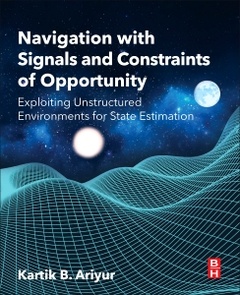Navigation with Signals and Constraints of Opportunity Exploiting Unstructured Environments for State Estimation
Auteur : Ariyur Kartik

Navigation with Signals and Constraints of Opportunity: Exploiting Unstructured Environments for State Estimation offers a conceptual framework for navigation and positioning using these sensors on the lines of standard control theory and dealing with navigation as state estimation in both indoor and outdoor environments.
Using signals and constraints of opportunity, the book shows how geomagnetic field, topography (changes in the direction of g locally), landmarks, angles to celestial bodies, local acoustics and presence of magnetic fields, and changes in background radiation (radio signals, Wi-Fi, etc.) can be integrated for accurate geolocation in place, or in conjunction with, GPS to aid inertial navigation.
Accelerometers, gyroscopes, cameras, magnetometers, microphones, and several other sensors are currently being produced in industrial scale, and as miniaturization advances, both price and portability are decreasing.
The authors have created and integrated several sensors that could be incorporated in navigation systems, cellphones, or automated irrigation devices. In this book, the fundamental problem of navigation is stated and the use of signals of opportunity is detailed and integrated into an alternative navigation framework.
- Provides elements for integrating natural fields into navigation strategy
- Covers fundamentals of positioning, navigation, and applications
- Presents concepts and algorithms suitable for navigation in air, ground, and underwater navigation?both indoors and outdoors
- Covers several sensors that could be incorporated in navigation systems, cell phones, or automated irrigation devices
1. The problem of navigation 2. Sensing and state estimation 3. The potential of some natural fields 4. Field Mapping and State Estimation via Interval Analysis 5. Global Recursive state estimation 6. Indoor Geolocation with Magnetic Mapping 7. Exploiting acoustic fields 8. Sensing the Sun for Orientation and Geolocation 9. Local landmarks and Lidar Self Calibration 10. Using local signals of opportunity
He has received his M.S and Ph.D. degrees in Mechanical and Aerospace Engineering from the University of California- San Diego in 1999 and 2000 respectively
Date de parution : 01-2019
Ouvrage de 412 p.
19.1x23.5 cm
Disponible chez l'éditeur (délai d'approvisionnement : 14 jours).
Prix indicatif 103,74 €
Ajouter au panier


